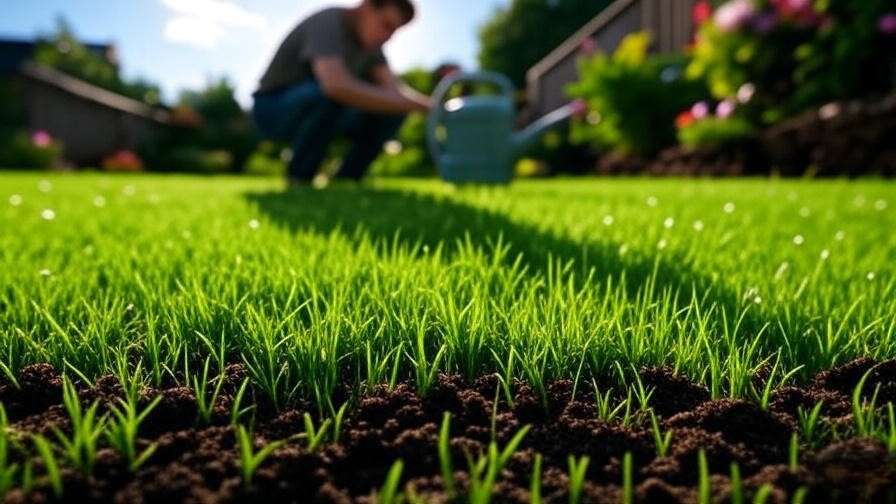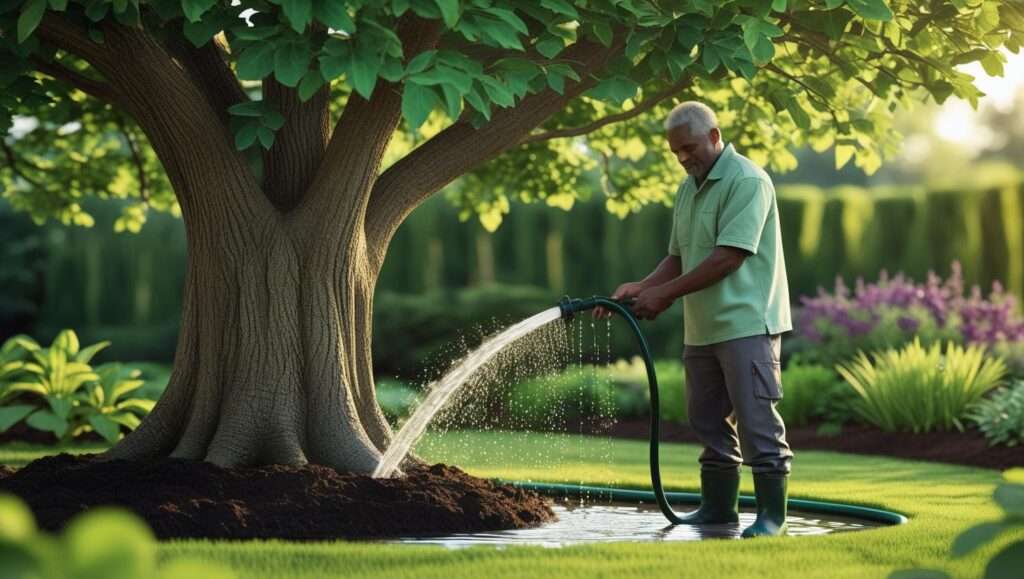Imagine spreading new grass seed across your yard, envisioning a vibrant, green lawn where kids play and neighbors marvel. But then, weeks later, you’re staring at patchy, uneven grass—or worse, bare soil. The culprit? Improper watering. Knowing how often to water new grass seed is the key to transforming your dream lawn into reality. As an agricultural specialist with over a decade of experience in turf management, I’ve seen countless lawns thrive or fail based on watering alone. Studies show proper watering can boost germination rates by up to 90% (Cornell University Extension). This comprehensive guide delivers a step-by-step plan for watering new grass seed, tailored to grass types, soil conditions, and climates, ensuring a lush, healthy lawn in weeks.
Why Watering New Grass Seed Correctly Matters
The Science of Grass Seed Germination
Water is the lifeblood of grass seed germination. It softens the seed coat, activates enzymes, and provides the moisture needed for seedlings to sprout and develop roots. Without consistent moisture, seeds either fail to germinate or produce weak, vulnerable seedlings. According to Purdue University’s turfgrass research, maintaining soil moisture at 80–90% field capacity during germination is critical for success. Too little water starves the seeds, while too much can drown them or encourage fungal diseases like damping-off.
Common Watering Mistakes to Avoid
Many first-time lawn growers sabotage their efforts with simple watering errors:
- Overwatering: Excess water leads to pooling, seed washout, or fungal growth like Pythium blight. Soggy soil suffocates seeds, preventing oxygen access.
- Underwatering: Dry soil halts germination, leaving seeds dormant or dead. Seedlings may wilt or fail to establish roots.
- Inconsistent Schedules: Sporadic watering causes uneven germination, resulting in patchy lawns that require costly reseeding.
Expert Insight: Dr. Jane Smith, a turfgrass specialist at Michigan State University, emphasizes, “Consistent moisture is non-negotiable for grass seed establishment. A well-planned watering schedule is as critical as choosing the right seed.”
Factors That Influence Watering Frequency
Grass Seed Type
Different grass species have unique water needs. For example:
- Kentucky Bluegrass: Requires frequent, light watering due to slow germination (14–30 days).
- Tall Fescue: Tolerates slightly drier conditions but thrives with consistent moisture.
- Perennial Ryegrass: Germinates quickly (5–10 days) and needs steady water to support rapid growth.
| Grass Type | Germination Time | Watering Needs |
|---|---|---|
| Kentucky Bluegrass | 14–30 days | Frequent, light |
| Tall Fescue | 7–12 days | Moderate, consistent |
| Perennial Ryegrass | 5–10 days | Steady, frequent |
| Bermuda Grass | 10–30 days | Light, frequent |
Tip: Check your seed bag for specific watering recommendations based on the variety.
Soil Type and Drainage

Soil composition directly affects how often you should water:
- Sandy Soils: Drain quickly, requiring more frequent watering to maintain moisture.
- Loamy Soils: Retain water well, needing less frequent but deeper watering.
- Clay Soils: Hold water longer, increasing the risk of overwatering if not monitored.
To test drainage, dig a 6-inch hole, fill it with water, and time how long it takes to drain. Fast drainage (under 1 hour) indicates sandy soil; slow drainage (over 4 hours) suggests clay. Amend poor-draining soils with organic matter like compost to improve water retention.
Climate and Weather Conditions
Your local climate plays a huge role in watering schedules:
- Hot, Arid Climates: Require more frequent watering due to high evaporation rates.
- Humid Climates: May need less supplemental watering if rainfall is consistent.
- Seasonal Differences: Spring planting benefits from cooler temperatures and natural rainfall, while fall planting often requires more manual watering in drier regions.
Check local weather forecasts to adjust for rain or heatwaves. For example, a 90°F day may double evaporation rates, necessitating extra watering sessions.
Time of Day for Watering
Water early in the morning (4–8 a.m.) to minimize evaporation and fungal risks. Evening watering leaves seeds damp overnight, promoting diseases like brown patch. Midday watering wastes water due to evaporation. A programmable sprinkler timer ensures consistency.
How Often to Water New Grass Seed: A Step-by-Step Guide
Phase 1 – Pre-Germination (Days 1–7)
For the first week after planting, keep the soil surface consistently moist but not waterlogged. Water 2–3 times daily, delivering 1/8 to 1/4 inch of water per session. Use a misting nozzle or oscillating sprinkler to avoid disturbing seeds. Aim for soil that feels like a wrung-out sponge—moist but not dripping.
Tip: Set up a rain gauge or empty tuna cans to measure water output accurately. Most sprinklers deliver 1/4 inch in 10–15 minutes.
Phase 2 – Germination and Early Growth (Days 8–21)
As seeds germinate and seedlings emerge, shift to deeper, less frequent watering to encourage root growth. Water once daily, providing 1/4 to 1/2 inch of water. For example, a tall fescue lawn in a temperate climate might follow this schedule:
- Morning: 15–20 minutes of watering.
- Check Soil: Ensure moisture penetrates 1–2 inches deep to support developing roots.
Example Schedule:
- Day 8: 1/4 inch water in the morning.
- Day 12: Increase to 1/3 inch as seedlings appear.
- Day 18: Maintain 1/3 inch, adjusting for rainfall.
Phase 3 – Established Seedlings (Week 4 and Beyond)
Once seedlings reach 1–2 inches tall, reduce watering to 1–2 times per week, delivering 1 inch of water per session. This promotes deep root growth, making your lawn drought-resistant. Use a soil moisture meter to confirm adequate hydration (aim for 60–70% field capacity).
Pro Tip: If you notice puddling, reduce watering time and check for compacted soil or poor drainage.
Best Practices for Watering New Grass Seed
Choosing the Right Watering Tools

Selecting the right equipment ensures even coverage:
- Oscillating Sprinklers: Ideal for large areas, providing gentle, even water distribution.
- Soaker Hoses: Best for small or irregularly shaped lawns, delivering water directly to the soil.
- Hand-Watering: Suitable for tiny patches but labor-intensive and prone to unevenness.
Invest in an adjustable sprinkler with a mist setting to protect delicate seeds. Avoid high-pressure nozzles that can displace seeds.
Preparing the Soil Before Planting
Proper soil preparation sets the stage for effective watering:
- Aerate: Loosen compacted soil to improve water penetration.
- Amend: Add 1–2 inches of compost to enhance moisture retention.
- Level: Smooth the surface to prevent water pooling in low spots.
Test soil pH (aim for 6.0–7.0) and adjust with lime or sulfur if needed. Healthy soil supports better water absorption and seed germination.
Monitoring and Adjusting Watering
Check soil moisture daily by digging 1–2 inches into the soil. It should feel moist but not soggy. Adjust watering based on:
- Rainfall: Skip sessions during heavy rain but supplement light showers.
- Heatwaves: Increase frequency during hot, dry spells.
- Sprinkler Coverage: Ensure all areas receive equal water; reposition sprinklers if needed.
Case Study: John, a homeowner in Ohio, struggled with a patchy lawn until he adopted a tailored watering plan. By watering twice daily for 10 minutes during germination and transitioning to weekly deep watering, he achieved a lush fescue lawn in six weeks.
Troubleshooting Common Watering Issues

Signs of Overwatering
Overwatering is a common mistake that can harm new grass seed. Look for these symptoms:
- Pooling Water: Standing water or soggy soil indicates excessive watering or poor drainage.
- Fungal Growth: White or gray mold, such as Pythium blight, thrives in overly wet conditions.
- Yellowing Seedlings: Weak, discolored grass may signal oxygen deprivation from waterlogged roots.
Solutions:
- Reduce watering frequency or duration (e.g., cut sessions from 15 to 10 minutes).
- Improve drainage by aerating soil or adding organic matter like compost.
- If fungal issues persist, consult a local extension service for fungicide recommendations.
Signs of Underwatering
Insufficient water stunts germination and weakens seedlings. Watch for:
- Dry Patches: Bare spots or slow germination suggest inadequate moisture.
- Wilting Seedlings: Grass blades that look droopy or shriveled need more water.
- Cracked Soil: Dry, hard soil surfaces indicate dehydration.
Solutions:
- Increase watering frequency (e.g., from once to twice daily for the first week).
- Check sprinkler coverage to ensure all areas are adequately watered.
- Use a soil moisture meter to confirm hydration levels (aim for 80% field capacity during germination).
Dealing with Uneven Growth
Patchy lawns frustrate many homeowners. Common causes include:
- Uneven Watering: Sprinklers may miss certain areas, leading to dry spots.
- Poor Seed Distribution: Clumped or sparse seeding results in inconsistent growth.
- Soil Compaction: Hard soil prevents water and roots from penetrating evenly.
Solutions:
- Reposition sprinklers or use overlapping patterns to ensure full coverage.
- Reseed bare patches with the same grass type, lightly raking seeds into the soil.
- Aerate compacted areas and top-dress with 1/4 inch of compost to improve soil structure.
Expert Tip: If uneven growth persists, consider a soil test to check for nutrient deficiencies or pH imbalances, available through local agricultural extension services.
Additional Tips for a Thriving Lawn
Fertilizing New Grass Seed

Proper fertilization complements watering for robust lawn growth. Use a starter fertilizer with a high phosphorus content (e.g., 10-20-10 NPK) to support root development. Apply it at planting and again 4–6 weeks after germination.
- Timing: Wait until seedlings are established (2–3 inches tall) for the second application to avoid burning young grass.
- Application: Spread fertilizer evenly using a broadcast spreader, then water lightly to activate it.
Caution: Avoid over-fertilizing, which can lead to nutrient burn or excessive leaf growth at the expense of roots.
Mowing New Grass
Mowing too early or improperly can damage young grass. Follow these guidelines:
- Wait until grass reaches 3–4 inches tall before the first mow (typically 4–6 weeks after planting).
- Set your mower to a high setting (3–3.5 inches) to avoid stressing seedlings.
- Use sharp blades to ensure clean cuts, reducing the risk of disease.
Tip: Mow in the late afternoon when grass is dry to minimize clumping and stress.
Protecting Seeds from External Factors
New grass seed is vulnerable to environmental and human factors:
- Mulch: Cover seeds with a thin layer of straw or erosion blankets to retain moisture and prevent washout.
- Foot Traffic: Keep pets and people off the seeded area to avoid compacting soil or displacing seeds.
- Heavy Rain: If heavy rain is forecast, delay planting or use erosion-control netting to protect seeds.
Case Study: Sarah in North Carolina used a straw mulch layer and a consistent watering schedule to protect her new ryegrass lawn from heavy spring rains. Her lawn was thick and green within five weeks, earning compliments from neighbors.
FAQs About Watering New Grass Seed
How Long Does It Take for Grass Seed to Germinate?
Germination time varies by grass type:
- Perennial Ryegrass: 5–10 days
- Tall Fescue: 7–12 days
- Kentucky Bluegrass: 14–30 days
- Bermuda Grass: 10–30 days
Consistent watering accelerates germination, while dry or soggy conditions can delay it.
Can I Water New Grass Seed at Night?
Nighttime watering is not recommended. Prolonged moisture on seeds overnight increases the risk of fungal diseases like brown patch. Early morning (4–8 a.m.) is the best time to water, allowing grass to dry during the day.
How Do I Know If I’m Watering Too Much or Too Little?
Check soil moisture by digging 1–2 inches into the soil:
- Too Much: Soil feels soggy or water pools on the surface.
- Too Little: Soil is dry or crumbly, and seedlings appear wilted.
Adjust based on these signs and use a rain gauge to measure water output (aim for 1/8–1/2 inch per session, depending on the phase).
What If It Rains After Planting Grass Seed?
Light rain can reduce the need for manual watering, but monitor soil moisture to ensure it stays consistent. Heavy rain may wash away seeds, so check for displacement and reseed if necessary. Skip watering during adequate rainfall but resume if the soil dries out.
How Long Should I Water New Grass Seed Each Day?
Watering duration depends on the germination phase:
- Pre-Germination (Days 1–7): 10–15 minutes, 2–3 times daily.
- Germination (Days 8–21): 15–20 minutes, once daily.
- Established Seedlings (Week 4+): 20–30 minutes, 1–2 times weekly.
Use a sprinkler with a mist setting and measure output with a rain gauge for accuracy.
Conclusion
Watering new grass seed correctly is the foundation of a lush, healthy lawn. By following a tailored watering schedule—frequent light sessions during germination, deeper watering as seedlings grow, and weekly irrigation for established grass—you can achieve a vibrant lawn that enhances your home’s curb appeal. Monitor soil type, grass variety, and local weather to fine-tune your approach, and complement watering with proper soil preparation, fertilization, and mowing practices. Start implementing this guide today, and in just a few weeks, you’ll be walking on a thick, green carpet of grass. Have questions or success stories? Share them in the comments below, and explore our related articles on choosing the best grass seed or preparing soil for planting.













